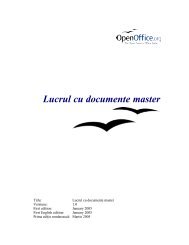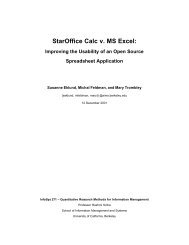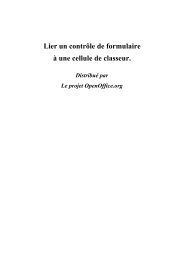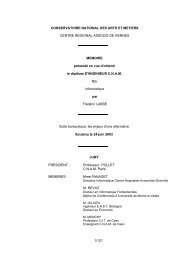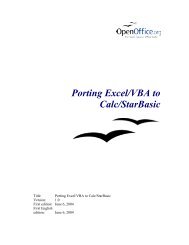The Microsoft Excel File Format - OpenOffice.org
The Microsoft Excel File Format - OpenOffice.org
The Microsoft Excel File Format - OpenOffice.org
You also want an ePaper? Increase the reach of your titles
YUMPU automatically turns print PDFs into web optimized ePapers that Google loves.
3.10 Control Tokens<br />
• Volatile Formula – <strong>The</strong> tAttrVolatile Token<br />
If the formula contains a volatile function (a function that needs to be recalculated always, for example the NOW<br />
function, ➜3.11), or a defined name that directly or indirectly includes a volatile function, this token will lead the token<br />
array (except in assignment-style formulas in macro sheets, see tAttrAssign token below).<br />
Token tAttrVolatile, BIFF2:<br />
Offset Size Contents<br />
0 1 19 H<br />
1 1 01 H (identifier for the tAttrVolatile token)<br />
2 1 Not used<br />
Token tAttrVolatile, BIFF3-BIFF8:<br />
Offset Size Contents<br />
0 1 19 H<br />
1 1 01 H (identifier for the tAttrVolatile token)<br />
2 2 Not used<br />
• IF Function Control – <strong>The</strong> tAttrIf Token<br />
This token always follows the first parameter of the IF function (containing the condition). It contains a relative offset<br />
that allows to skip the true parameter of the function (second parameter), if the condition evaluates to false.<br />
<strong>The</strong> token promises that the topmost operand on the formula stack (the last processed subexpression) is the condition of<br />
an IF function. This operand is popped from the stack, and processing continues depending on its value.<br />
• If the condition is true, the following tokens are processed, and at the end of the parameter, a tAttrSkip token (see<br />
below) will occur that jumps right behind the tFuncVar(IF) token (this has to be assured during creation of the<br />
formula). Thus, the false parameter is not evaluated at all, and cannot cause an error code as final formula result, if it<br />
contains an error.<br />
• If the condition is false, the following tokens are skipped (the true parameter), and evaluation continues with the false<br />
parameter. Again, at the end of the parameter, a tAttrSkip token will occur that jumps behind the tFuncVar(IF) token.<br />
If the false parameter does not exist, the tAttrIf token causes to jump to the tFuncVar(IF) token, and a simple false<br />
constant is pushed onto the formula stack.<br />
If the IF function is processed, the result of either the true parameter or the false parameter will be on top of the formula<br />
stack.<br />
Token tAttrIf, BIFF2:<br />
Offset Size Contents<br />
0 1 19 H<br />
1 1 02 H (identifier for the tAttrIf token)<br />
2 1 Distance (number of bytes) from start of next token (first token of second parameter) to<br />
start of first token of the false parameter (if extant); otherwise to start of the respective<br />
tFuncVar(IF) token. See example below for more details.<br />
Token tAttrIf, BIFF3-BIFF8:<br />
Offset Size Contents<br />
0 1 19 H<br />
1 1 02 H (identifier for the tAttrIf token)<br />
2 2 Distance (number of bytes) from start of next token (first token of second parameter) to<br />
start of first token of the false parameter (if extant, including all leading tAttrSpace<br />
tokens); otherwise to start of the respective tFuncVar(IF) token (skipping all leading<br />
tAttrSpace tokens related to the tFuncVar token). See example below for more details.<br />
67





